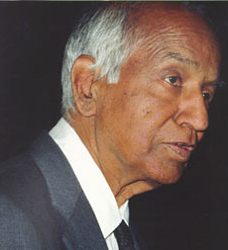Subrahmanyan Chandrasekhar, a Nobel Laureate in Physics and one of the greatest astrophysicists of modern times was born on October 19, 1910 in Lahore,  (now in Pakistan) to parents Chandrasekhara Subrahmanya Ayyaa civil servant and Sita Balakrishnan. Being the nephew of the great, C.V. Raman, a Nobel Prize winner in Physics young Chandrashekhar's interest in the subject came naturally to him.
(now in Pakistan) to parents Chandrasekhara Subrahmanya Ayyaa civil servant and Sita Balakrishnan. Being the nephew of the great, C.V. Raman, a Nobel Prize winner in Physics young Chandrashekhar's interest in the subject came naturally to him.
 (now in Pakistan) to parents Chandrasekhara Subrahmanya Ayyaa civil servant and Sita Balakrishnan. Being the nephew of the great, C.V. Raman, a Nobel Prize winner in Physics young Chandrashekhar's interest in the subject came naturally to him.
(now in Pakistan) to parents Chandrasekhara Subrahmanya Ayyaa civil servant and Sita Balakrishnan. Being the nephew of the great, C.V. Raman, a Nobel Prize winner in Physics young Chandrashekhar's interest in the subject came naturally to him. In 1930, at the age of 19, he completed his degree in Physics from Presidency College, Madras and went to England for postgraduate studies at the Cambridge University. Chandrasekhar was noted for his work in the field of stellar evolution, and in the early 1930s he was the first to theorize that a collapsing massive star would become an object so dense that not even light could escape it; now known as the Black hole. He demonstrated that there is an upper limit ( known as 'Chandrasekhar Limit' ) to the mass of a White dwarf star. His theory challenged the common scientific notion of the 1930s that all stars, after burning up their fuel, became faint, planet-sized remnants known as white dwarfs. But today, the extremely dense neutron stars and black holes implied by Chandrasekhar’s early work are a central part of the field of astrophysics.
Initially his theory was rejected by peers and professional journals in England. The distinguished astronomer Sir Arthur Eddington publicly ridiculed his suggestion that stars could collapse into such objects( black holes). Disappointed, and reluctant to engage in public debate, Chandrasekhar moved to America and in 1937 joined the faculty as an Assistant Professor of Astrophysics at the University of Chicago and remained there till his death. At Chicago, he immersed himself in a personalized style of research and teaching, tackling first one field of astrophysics and then another in great depth. He wrote more than half a dozen definitive books describing the results of his investigations. More than 100,000 copies of his highly technical books have been sold. He also served as editor of the Astrophysical Journal, the field’s leading journal, for nearly 20 years; presided over a thousand colloquia; and supervised Ph.D. research for more than 50 students.
No comments:
Post a Comment